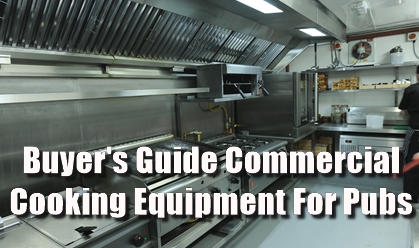Equipping a commercial kitchen from scratch or replacing worn out catering equipment in an existing kitchen is going to be one of the most expensive undertakings you are likely to undertake. Getting the right equipment to suit your cooking needs is vital. A kitchen, of course, is a place to cook and the most important pieces of catering equipment you will need are good quality commercial cookers. Gas or electric or a combination of both, the choice is huge so here is some help on making informed choices
Gas Ranges
A good gas range is the centre and the soul of any pub kitchen and every pub kitchen is different so choosing the best unit to suit your specific needs can be a challenge, but if you keep a couple things in mind buying the range you need shouldn’t be hard.
BTUs and Gas Type
Commercial ranges vary in the heat output they produce, which is measured in BTUs (British Thermal Units). Depending on the cooking application and energy usage concerns, you may want to purchase a unit with a higher or lower BTU rating.
Higher BTU ranges are going to heat things faster, but at a higher rate of energy consumption. A higher BTU rating also means quicker heat recovery times.
Lower BTU rates will heat things more slowly, but more efficiently. Lower BTU ratings mean a slower heat recovery time
Most gas ranges are outfitted for natural gas. Natural gas is the most common gas type and chances are you are connected to natural gas. LP gas or liquid propane is the gas you get if your range is connected to a propane tank, usually for rural locations (where no mains gas is available) or portable operations.
Casters allow you to move your commercial gas range quickly and easily for cleaning or rearranging. Manufacturers charge a ridiculous fee for casters that come with their cooking equipment but you can buy your casters separately and make a saving.
Gas ranges today use two basic types of ignition sources, standing pilot and electric. A stove with a standing pilot has a small, continuously burning gas flame under the cooking area. When the stove is turned on, this flame lights the gas flowing out of the burners. The advantage of the standing pilot system is that it is simple and completely independent of any outside power source. A minor drawback to this type of appliance is that the flames continuously consume fuel even when the stove is not in use.
Electric ignition ranges use electric sparks to ignite the surface burners. This is the “clicking sound” you hear just before the appliance burner actually lights.
Open Gas Burners
Open gas burner commercial ranges are the top choice for most professional kitchens and provide instant, easily controlled heat. Look for easily removable top grates, a wide range of flame heights, ring or star burners and individual pilot lights/igniters for each burner. Four, six and even eight burner ranges are available depending on what you think you will need to run an efficient food service. Also, you should think about the BTU rating to achieve the balance of fuel economy and speed of service.
Solid Ranges
Heated by a powerful central burner the cooking area is solid with concentric removable central rings that can be removed for direct heating (for instance wok cooking). The solid range is hottest at its centre with cooler areas to the edges, they are harder to use but once you are used to it a solid range can be a more versatile tool than an open burner range.
Charbroilers
Charbroilers allow you to broil poultry, seafood, and meat quickly and effectively. Most commercial kitchens purchase a separate charbroiler unit, but combination range and charbroiler units can be ordered. (You probably won’t need this piece of equipment in the average pub kitchen.)
Continue reading … page 2
